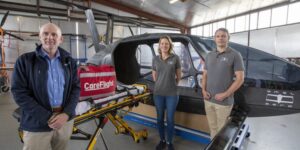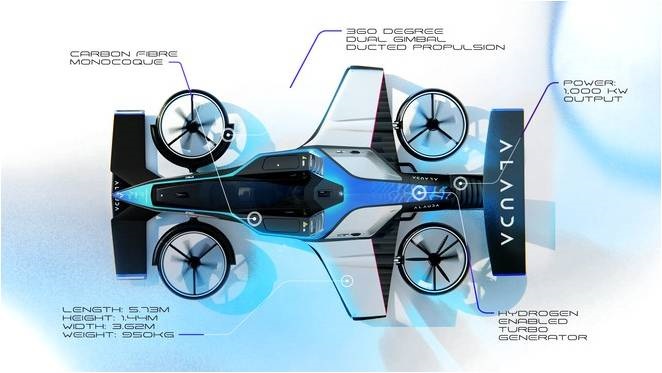Alauda and AMSL – two companies down under – are pressing ahead on divergent missions, but both powering “flying cars” with hydrogen. Both craft will achieve higher speeds and cover longer ranges than most other electric Vertical Take Off and Landing (eVTOL) craft.
Alauda Airspeeder MK4
Alauda’s brief history of creating Airspeeders hits its latest iteration, the MK4. It replaces batteries with a 1,000 kilowatt hydrogen-fueled turbo generator driving ducted fans in place of previous open rotors. Up to now, the various Marks were remotely controlled and battery powered. MK4s will be “crewed” and powered by green hydrogen.
Evolved over the last few years, MK4 will be much faster than its 100 kilometer per hour predecessors, and we hope, more controllable. Remotely controlled crashes, as shown in this2022 MK3 race, are no more harmful to human operators than a video game – although probably more costly.
Looking a great deal like a Formula 1 or Formula e race car, the Alauda Airspeeder moves like one, too. According to fuelcellworks.com, Matt Pearson, CEO of the firm, shares his ambitious outlook. ““We, and the world, are ready for crewed flying car racing. We have built the vehicles, developed the sport, secured the venues, attracted the sponsors and technical partners. Now is the time for the world’s most progressive, innovative and ambitious automotive brands, OEM manufacturers and motorsport teams to be part of a truly revolutionary new motorsport. In unveiling the crewed Airspeeder Mk4 we show the vehicles that will battle it out in blade-to-blade racing crewed by the most highly-skilled pilots in their fields.”
At only 950 kilograms (2,094 pounds) and with 1,000 kilowatts (1,340 horsepower) on tap from its Thunderstrike Hydrogen Generator, the MK4 should be capable of its projected 360 kilometers per hour (225 mph) top speed, claimed to be attained in only 30 seconds by its maker.
Considering the three-dimensional, low-altitude racetrack on which Airspeeders will be deployed, one is glad to see the propellers ducted and protected from too many potential disasters. One hopes for adequate safety measures to protect the pilot and reflects on how such races will resemble the pod racers in Star Wars.
Pearson foresees his little wonders evolving into more prosaic air cars for personal transport, something we’ve all been waiting since the Jetsons first aired.
AMSL Vertiia
Australia’s AMSL Aero test flew its Vertiia electric Vertical Take Off and Landing (eVTOL) vehicle tethered but lifting off vertically. The compact box-wing, biplane configuration is intended primarily for the aeromedical world, and can also be used for sky taxi applications. Interestingly, the Beta Alia and the recently flown NUNCAT Zenith are intended primarily for medical transport.
AMSL Co-Founder Siobhan Lyndon explained its usefulness for rural and regional communities, offering “rapid and low-cost connectivity.” “Vertiia is not only safe and quiet, but it was also developed for the harsh long-distance conditions in Australia. If it can work in Australia, it can work anywhere.”
Her co-founder husband Andrew Moore adds a note on range. “”If you can solve the long range problem, short range is easy. If you only build a short range aircraft, then long range is impossible.” The hydrogen-powered craft will use its eight tilting propellers to not only lift it skyward, but to propel it at speeds up to 300 kilometers per hour (180 mph) over a 1,000 kilometer (620 mile) range.

The Australian invention could “transform patient outcomes in vulnerable regional and remote communities,” according to CareFlight CEO Mick Frewen, shown here with Vertiia developers Siobhan Lyndon and Andrew Moore
Able to carry five people in a space equivalent to two compact cars, the Vertiia will be able to serve patients in the far-flung reaches of Australia. Miss Lyndon comments comments on the craft’s utility and versatility. “Unlike aeromedical aeroplanes that require a runway, Vertiia will carry patients directly from any location straight to the hospital, significantly reducing the complexity and time often required to transport vulnerable patients. It will also be quieter and safer than helicopters and will eventually cost as little as a car to maintain and run, transforming aeromedical transport into a far more affordable, accessible, safer and reliable option.”
Hydrogen power was an early choice and tanks holding it will connect the ends of the wings – adding to the strength of the machine and enabling the projected long range – essential in such a big country. Moore notes that also makes the tanks more aerodynamic, helping to reduce drag.
Both these diverse aircraft will help herald a new age in purposeful flight. Let’s wish all these creative souls success. One does wonder how the Formula air racer will be transformed to to a tamer urban runabout, though.

